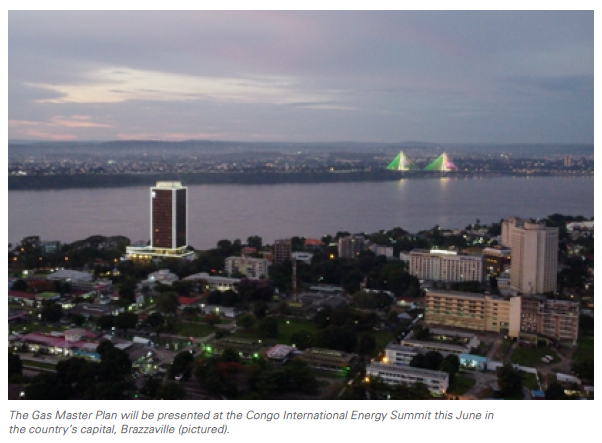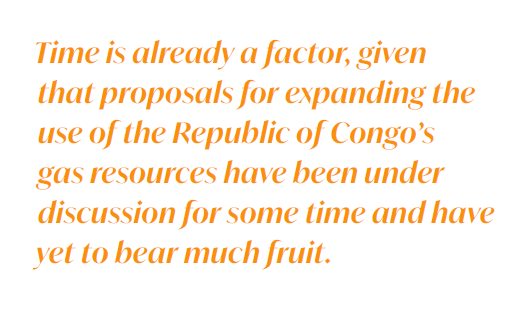Weighing up the Republic of Congo’s Gas Master Plan [Gas in Transition]
The Republic of Congo is not one of Africa’s largest gas producers, but it does possess sizeable reserves of natural and associated gas. As of the end of last year, it was believed to have at least 10 trillion ft3 (283bn m3) of gas, making its reserves the seventh largest on the continent.
Thus far, the international oil companies (IOCs) working in the Republic of Congo have found two uses for the country’s gas, much of which is associated gas from offshore oilfields. They have re-injected much of this gas into their oilfields in order to keep reservoir pressures high and optimise recovery rates.
To some extent, though, they have also pumped some gas ashore to the local market. Domestic demand for gas is relatively low, as transportation and distribution infrastructure is relatively sparse. However, it is slowly expanding – and there are a number of customers within the Republic of Congo.
Italy’s Eni, for example, has been delivering gas from fields within the Marine XII offshore block to two onshore thermal power plants (TPPs) for use in electricity generation. These TPPs, known as Central Electrique du Congo (CEC) and Central Electrique du Djeno (CED), account for the majority of the country’s electricity output. CED, which is owned 20% by Eni, makes up nearly 70% of total power production on its own.
These efforts are commendable, insofar as they treat associated gas as a useful substance that ought to be conserved and put to work for the benefit of IOCs and the host country rather than treated as a nuisance and simply flared off into the atmosphere, no matter the long-term effect. But as far as officials in Brazzaville are concerned, they are not sufficient. The Congolese government is looking to shift its focus from oil toward gas, thereby reducing its own reliance on crude export revenues and expanding domestic access to a new source of energy.
To this end, the country’s hydrocarbons ministry teamed up with Wood Mackenzie last year to draw up a Gas Master Plan (GMP) for optimal utilisation of the country’s associated gas resources. This plan, which was drafted with guidance from state-owned Societe Nationale des Petroles du Congo (SNPC), has a domestic gasification component but also talks about how the Republic of Congo might become a gas exporter.
Full details still under wraps
Few details on this plan have been made public. Instead, the ministry said in a press release in late January that the GMP and other strategies would be unveiled at the Congo International Energy Summit (CIES), the first event of its kind, which will take place in Brazzaville in mid-June of this year.
It also offered a few insights into the sorts of strategies that Congolese authorities are contemplating, as well as the challenges they are anticipating. It said, for example, that the government sees floating LNG (FLNG) as an optimal solution for turning the country into a gas exporter – and that Eni’s Marine XII block was a “prime target” for such an approach. It noted the high cost of FLNG solutions and suggested that the Republic of Congo would have to make some substantial policy changes to make gas projects attractive to investors.
The press release also argued that the success of existing gas-to-power (GTP) initiatives was a signal that Brazzaville was far ahead of neighbouring states with respect to establishing the proper framework for its domestic gas industry. Nevertheless, it also stressed the need for domestic policy reform to ensure competitiveness and pricing stability.
A plausible but very complicated path
It is difficult to deliver a comprehensive assessment of the GMP at this point. The document drawn up by the ministry and WoodMac is still under wraps, and there may very well be some revisions made to that document before the CIES begins in Brazzaville in June. Nevertheless, some of the details that have come to light thus far raise questions about the feasibility of the plan.
Those questions are not rooted in the size of the country’s reserves. As noted above, the Republic of Congo’s resources are substantial.
In fact, David Thomson, vice president for sub-Saharan Africa research at Welligence Energy Analytics, describes them to NGW as large enough to make the GMP a plausible option for future development. “Congo does have sufficient gas resources to support a fairly small-scale FLNG project as well as supplying domestic needs,” he says.
Thomson also cautions, though, that Brazzaville might be hard-pressed to realise its ambitions. He alludes to the fact that Eni’s Marine XII block was not the only licence area that contained both crude oil and natural gas, noting that multiple IOCs were active in different sections of the Congolese offshore zone. “[A] lot of the [gas] resource is in separate blocks/fields, which would add complexity and require coordination with different operators,” he says. The need to bring multiple parties together is also likely to add to the time and expense of gas utilisation initiatives, he adds.
Time is already a factor, he comments, given that proposals for expanding the use of the Republic of Congo’s gas resources have been under discussion for some time and have yet to bear much fruit. So far, he says, Brazzaville does not seem to have introduced the policies needed to attract serious attention and investment to gas projects, to say nothing of shifting the spotlight away from crude oil. “[The] project on Marine XII has been talked about for many years without tangible progress,” he tells NGW. “The value in Congo is still in oil, and without significant incentives, operators will be reluctant to go after the gas.”
Focus on FLNG increases cost and complexity
Thomson also questions the economics of the plan, noting that the small-scale FLNG option mentioned in the Ministry of Hydrocarbons’ press release was likely to prove relatively costly. He did not elaborate, but his statement is in line with the conclusions of many other industry observers – not least among them WoodMac, the consultancy that helped the ministry draw up the GMP.
In an article summarising the conclusions from its Global FLNG Overview 2019 report, WoodMac highlighted the advantages of FLNG over other solutions for gas monetisation. It noted that floating liquefaction plants were more economical than their onshore counterparts for smaller-scale fields, meaning that they could open up stranded reserves more quickly and at lower costs.
Even so, these advantages are relative. A review of contract awards for the construction of newbuild FLNG vessels or the conversion of tankers into FLNG units indicates that the establishment of floating gas liquefaction plants is still a difficult and expensive process that is likely to require several years and several billion dollars. It may also necessitate the integration of the upstream and FLNG components of the project, thereby increasing the overall cost and complexity of gas development, according to WoodMac.
More plausible than feasible?
It is not yet clear exactly what kind of FLNG solution the Republic of Congo intends to apply to the gas reserves in its offshore zone. So far, the hydrocarbons ministry has said only that it is looking at small-scale FLNG projects and that it views Marine XII as a “prime target” for this approach.
In theory, Brazzaville is ready to take this approach. That is, it does have enough gas to support exports as well as domestic gasification, and it has publicly stated its willingness to make policy changes in order to foster gas development and to make the sector more attractive to foreign investors.
But it will also have to back up these shows of commitment in June, when it officially unveils the GMP at the CIES event in June. Moreover, it will have to convince investors that it is worth the cost of the gas projects – and that includes the IOCs that are already working there, such as Eni and France’s TotalEnergies. According to Thomson, this may prove difficult. “It is also questionable how core Congo is amongst global portfolios for Eni and TotalEnergies,” he says.



